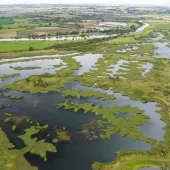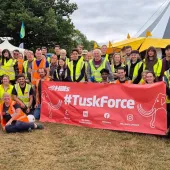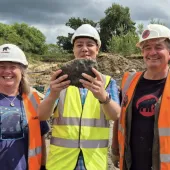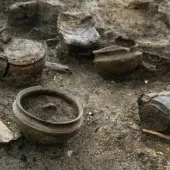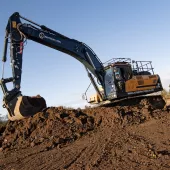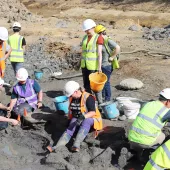Quarrying And The Ice Age
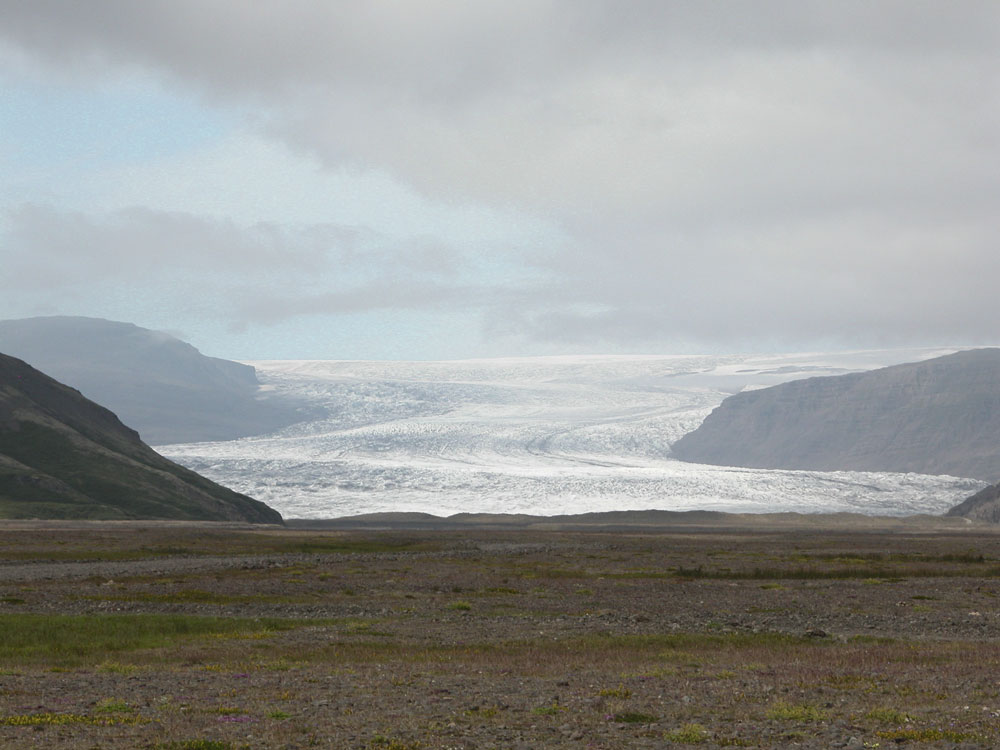
The hidden benefits of extraction
It is time to celebrate one of the little appreciated but fundamentally important contributions that quarrying makes to science and society. Sand and gravel quarrying is the single most important way in which significant remains from our Ice Age past are uncovered. These remains are significant because they provide evidence of past climates and environments over a period of hundreds of thousands of years. This is fascinating in itself, revealing the story of the evolution of our landscape and the changing plants and animals (including early humans) that inhabited it. More importantly, perhaps, it is only by understanding the complex patterns of past climate and environmental change that we can hope to understand what the future might hold at a time when there is widespread concern about the impact of global warming. Largely unsung, the quarrying industry plays a major role in this enterprise.
The main aims of this article are:
- To describe the kinds of evidence from our Ice Age past that quarrying reveals.
- To characterize how the evidence is found, recorded and recovered.
- To outline the relevant planning policies and how giving due attention to Ice Age remains forms part of the conservation effort of the minerals industry.
- To introduce an initiative, the National Ice Age Network (NIAN), which aims to help both quarrying companies and scientists get the most out of the opportunities provided by quarrying.
Deep understanding
Usually deeply buried within or beneath deposits of sands and gravels can be found various types of remains that are scientists’ main direct source of evidence for piecing together the story of Ice Age Britain.
This is a very important and exciting story. It concerns past climate change — during the last 800,000 years or so there have been roughly nine major cold periods (glacials) and a corresponding number of warm periods (interglacials) as well as many more shorter-term climate fluctuations, some of them dramatic and rapid. At their most extensive, around 450,000 years ago, ice sheets, perhaps a mile thick, reached as far south as northern London (fig. 1). As the ice sheets waxed and waned, so the sea level fell and rose, the water alternately becoming locked up in the great ice sheets and then released from them; Britain was sometimes a peninsula of Europe and sometimes an island.
The massive forces involved in the advance and retreat of glaciers repeatedly reshaped the British landscape. Great river systems appeared, survived for thousands of years and then were fundamentally altered or obliterated. It was of course these rivers, at times of high-energy flow, such as arise when glacial ice and snow melts, that carried a burden of rocks torn from the ground, to be ultimately deposited downstream as gravels and sands, thereby creating the natural resource that is of such value to society today (fig. 2).
If their secrets can be unlocked, these sands and gravels, and what they contain, can tell us the story of Ice Age Britain. During warm periods the rivers flowed more gently, depositing mud and silts. Animals, such as elephants and even hippos, came down to the waters edge to drink or wallow (fig. 3). Some died here and sometimes their bones became incorporated into the muds and silts, occasionally surviving down to the present day along with the bones of smaller animals. In colder times it might be mammoth or woolly rhino (fig. 4). Other organic remains can be preserved in these deposits too; plants of the river or river’s edge, for example, or microscopic pollen blown in from plants growing further afield. Even beetles or other insects may be preserved, along with molluscs.
Taken together, these remains — the fossils of vertebrate and invertebrate animals, plant remains and the sediments that contain them — allow scientists to reconstruct the changing climate, landscapes and environments of Britain (beetles, for example, are very sensitive to temperature and can be used to reconstruct climate). Furthermore, early humans were also on the scene. Until the last part of the Ice Age these were not Homo sapiens but our ancestors and ‘cousins’, such as the Neanderthals. Traces of their activity, usually just simple stone tools, can also be found in the deposits buried deep within or below the sands and gravels (see the case study by Jenni Chambers on page 23).
The British data set for interpreting and understanding the Ice Age is probably the best in Europe, and Britain is home to much internationally acclaimed scientific research on the problem. Only recently the science journal Nature reported on findings from Britain that have pushed back the earliest human occupation of northern Europe by more than 200,000 years, with ongoing research in quarries hinting at the possibility that the date of earliest occupation may need to be doubled, from a date of around 500,000 years ago, until recently accepted by most scholars, to perhaps over a million years. These are exciting times for science and partnership with the quarrying industry has never been more important.
Discovering and recording Ice Age remains
Most studies of Ice Age remains are better characterized as geology rather than archaeology — they are about analysing deposits that were laid down over geological time and the fossils that these deposits contain. Because the Ice Age (the Pleistocene epoch of the Quaternary period in geological terms) is the most recent geological epoch, we are dealing with ‘drift’ rather than ‘solid’ geology, but the principles are fundamentally the same.
Ice Age remains differ from most archaeological remains because they are generally deeply buried within and beneath the deposits of sand and gravel (fig. 5). This has two important consequences. First, it is much more difficult to accurately evaluate where significant Ice Age remains will survive. There are of course some ways that their possible presence can be roughly predicted, mostly based on an understanding of the general geological and geomorphological context of the area. However, the great majority of the Ice Age remains uncovered during quarrying are best classified as ‘chance finds’. The second important consequence of significant Ice Age deposits being deeply buried is that they will be discovered during quarrying, not before it begins.
What the Quaternary scientist is looking for is exposures of significant deposits, particularly those containing fossils, and this is what quarrying often provides. When a significant deposit is exposed the Quaternary scientist will want to record various details and to take samples of the deposit for subsequent analysis in the laboratory. Typically the fieldwork is quick, unobtrusive and does not interfere in any significant way with quarrying (fig. 6).
For more than a century this scientifically important work has gone on quietly in quarries up and down the country. Quaternary scientists or Palaeolithic (Old Stone Age) archaeologists have built up good working relationships with the managers of quarries known to produce significant remains. Sometimes this working relationship has blossomed into a friendship, especially when the manager and the quarry personnel become interested in the work and appreciate its importance. This, in turn, has often led to the quarry personnel developing an ‘eye’ for the sorts of deposits and fossils the scientists are interested in and getting in touch when something of potential interest is found (fig. 7).
Ice Age remains, the planning process and sustainable quarrying
In recent decades, appropriate consideration of significant Ice Age remains uncovered during quarrying has been incorporated into the planning process. The ‘dual character’ of these remains — they are both geological and also sometimes archaeological — means that they are covered by two principal planning policy documents: PPS9 (Biodiversity and Geological Conservation) and PPG16 (Archaeology and Planning). Thus, they also fall into an area of ‘overlap’ between the purview of Natural England (geology) and English Heritage (archaeology). Both agencies have provided guidance booklets of relevance to the minerals industry that cover Ice Age remains1, the Natural England booklet being jointly produced with the QPA and SAMSA. Increasingly, it is a condition of planning that appropriate steps are taken to monitor new extraction sites for significant Ice Age remains and that adequate measures are taken to record such remains should they be uncovered.
Of course, quarry operations that obtained permission prior to the introduction of such requirements are under no obligation to take steps to deal with any significant Ice Age remains that may turn up, nor to provide access to Quaternary scientists and archaeologists keen to study these. In part this is compensated for by the long tradition of voluntary co-operation with Quaternary scientists and Palaeolithic archaeologists. Furthermore, the industry as a whole is taking a proactive approach to the conservation of geodiversity. Emblematic of this is the signing last year by English Nature and the QPA of two ‘memoranda of understanding’2 concerning the conservation and enhancement of biodiversity and geodiversity. In these memoranda the parties agreed to co-operate, among other things, on the following:
- Working together to identify, develop and disseminate good practice relating to the impacts and potential opportunities that may arise as a result of mineral extraction in England.
- Supporting, encouraging and publicizing those operations .... that make a positive contribution to the conservation and enhancement of biodiversity and geodiversity.
- Encouraging mineral extraction companies to produce corporate Biodiversity and Geodiversity Action Plans within five years.
In the context of sand and gravel quarrying, the geodiversity essentially is the type of ‘significant Ice Age chance finds’ that have been described in this article. Given their character, in-situ conservation of such remains is very seldom either practical or desirable. What is generally required is ‘preservation by record’ — the sort of simple recording procedures outlined above.
These developments present a range of challenges and opportunities for all parties, which the National Ice Age Network (NIAN) project, jointly funded by Natural England and English Heritage through their respective ALSF schemes, has been set up to help with.
The National Ice Age Network
The first task of NIAN (a collaboration between the Universities of Birmingham, Royal Holloway [London], Leicester and Southampton, each with a regional remit) is to raise awareness of the interest and importance of Ice Age remains uncovered during quarrying within the industry, among the ‘heritage community’, and among the wider public. This is being done through leaflets, events and exhibitions, articles, talks and the web site www.iceage.org.uk (fig. 8). It is important to get the message right — the possibility of significant Ice Age remains is an ‘opportunity’ not a ‘constraint’; it is a positive benefit of, and not an argument against, quarrying.
Perhaps the greatest challenge that has to be faced is the uneven coverage of monitoring quarries for significant Ice Age remains. At some quarries, either through voluntary collaboration with researchers or as a consequence of planning conditions, monitoring for significant Ice Age remains is well covered. At other quarries, which may have just as much potential for these remains, nothing is being done. Often, this may simply be because people do know that these remains are important or what to look out for. Thus, NIAN has produced a series of ‘recognition sheets’ covering such topics as: vertebrate fossils; insects, molluscs and plant remains; stone tools; and sediments. Each well illustrated sheet provides the basic information needed for the recognition of the various classes of finds and explains why they are important (fig. 9). The project is also producing a handbook, Quarrying and the Ice Age, which provides this information in more detail, along with further practical advice and background information on the Ice Age and its importance.
By far the best-placed people to monitor quarries for significant Ice Age finds are the quarry personnel themselves; they are, after all, the only people with a continuous presence on site during extraction. The amount of effort involved is minimal, and if the conservation of geodiversity is to be taken seriously it represents by far the best use of resources compared to the conceivable alternatives. Quite a few quarries already operate this sort of ‘self-monitoring’, contacting the specialists when something of importance turns up so that rapid recording and sampling can take place. A major goal of NIAN is that this existing good practice should be spread more widely. NIAN can provide the tools for the job together with the expertise and back-up when something of potential interest turns up.
For simple reasons of geology, different quarries do not have equal potential for the discovery of significant Ice Age remains. Valuable time and resources are best devoted to those quarries with the highest potential (while not ignoring the possibility of the occasional surprise). One intended output of the NIAN project was to carry out a survey of all active sand and gravel quarries and rate their potential on a simple scale of ‘low’, ‘medium’ or ‘high’. Then effort could be targeted most effectively. At the time of writing, however, the QPA has adopted the position that collaboration with this initiative is not currently in their members’ best interests, at least until wider archaeological issues affecting quarrying are resolved. We hope, however, that in due course the long-term benefits of such a survey will be appreciated.
In short, NIAN aims to help quarrying companies achieve the goal of sustainable development and sensitive mineral extraction. Assistance can be provided, whether taking adequate account of Ice Age remains is a condition of planning or whether this is viewed simply as an aspect of good quarry management, irrespective of planning requirements. Help with the preparation of Environmental Impact Assessments and Geodiversity Action Plans is also available. Ideally, what NIAN would like to see is the adoption by the industry of a ‘code of practice’ relating to the recognition, reporting and recording of significant Ice Age remains uncovered during quarrying. Such a code could be deployed either voluntarily or as an appropriate response to typical planning conditions. A code developed in partnership with the industry would ensure proportionality of response and consistency of practice across the country. It would represent a ‘proactive’ rather than ‘passive’ response to the recognition of the enormous contribution quarrying can make to understanding past climates and environments and, through this, to a better understanding of our uncertain climate future.
References
- ‘Geodiversity and the minerals industry – conserving our geological heritage’, English Nature, Quarry Products Association and Silica and Moulding Sands Association, 2003. ‘Identifying and protecting Palaeolithic remains – archaeological guidance for planning authorities and developers’, English Heritage, 1998.
- ‘Overarching Memorandum of Understanding’, English Nature and the Quarry Products Association, 27 June 2005. ‘Terrestrial Operations: Memorandum of Understanding’, English Nature, The Quarry Products Association and The Silica and Moulding Sands Association, 27 June 2005.


